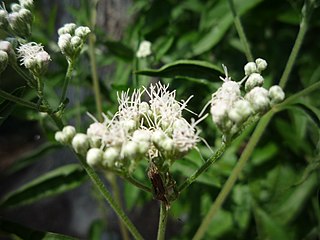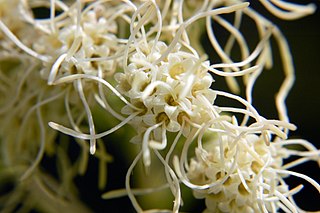
Symphyotrichum novae-angliae is a species of flowering plant in the aster family (Asteraceae) native to central and eastern North America. Commonly known as New England aster, hairy Michaelmas-daisy, or Michaelmas daisy, it is a perennial, herbaceous plant usually between 30 and 120 centimeters tall and 60 to 90 cm wide.

Eupatorium is a genus of flowering plants in the family Asteraceae, containing from 36 to 60 species depending on the classification system. Most are herbaceous perennials growing to 0.5–3 m (1.6–9.8 ft) tall. A few are shrubs. The genus is native to temperate regions of the Northern Hemisphere. Most are commonly called bonesets, thoroughworts or snakeroots in North America. The genus is named for Mithridates Eupator, king of Pontus.

Symphyotrichum ericoides, known as white heath aster, frost aster, or heath aster, is a species of flowering plant in the family Asteraceae native to much of central and eastern North America. It has been introduced to parts of Europe and western Asia.

Eupatorium perfoliatum, known as common boneset or just boneset, is a North American perennial plant in the family Asteraceae. It is a common native to the Eastern United States and Canada, widespread from Nova Scotia to Florida, west as far as Texas, Nebraska, the Dakotas, and Manitoba. It is also called agueweed, feverwort, or sweating-plant. In herbal medicine, the plant is a diaphoretic, or an agent to cause sweating. It was introduced to American colonists by natives who used the plant for breaking fevers by means of heavy sweating, and commonly used to treat fever by the African-American population of the southern United States. The name "boneset" comes from the use of the plant to treat dengue fever, which is also called "break-bone fever." It is nearly always found in low, wet areas.

Eutrochium is a North American genus of herbaceous flowering plants in the family Asteraceae. They are commonly referred to as Joe-Pye weeds. They are native to the United States and Canada, and have non-dissected foliage and pigmented flowers. The genus includes all the purple-flowering North American species of the genus Eupatorium as traditionally defined, and most are grown as ornamental plants, particularly in Europe and North America.

Eupatorium altissimum, with the common names tall thoroughwort and tall boneset, is a perennial herbaceous plant in the Asteraceae family with a native range including much of the eastern and central United States and Canada. It is a tall plant found in open woods, prairies, fields, and waste areas, with white flowers that bloom in the late summer and fall.

Eupatorium serotinum, also known as late boneset or late thoroughwort, is a fall-blooming, perennial, herbaceous plant native to North America.

Eupatorium album, or white thoroughwort, is a herbaceous perennial plant in the family Asteraceae native from the eastern and southern United States, from eastern Texas to Connecticut, inland as far as Indiana.

Eupatorium resinosum, the pine barren thoroughwort, is a rare North American plant species in the family Asteraceae.

Eupatorium sessilifolium, commonly called upland boneset or sessile-leaved boneset, is a North American plant species in the family Asteraceae. It is native to the eastern and central United States, found from Maine south to North Carolina and Alabama, and west as far as Arkansas, Kansas, and Minnesota.

Conoclinium coelestinum, commonly known as blue mistflower, mistflower, wild ageratum, or blue boneset, is a North American species of herbaceous perennial flowering plant in the family Asteraceae. It was formerly classified in the genus Eupatorium, but phylogenetic analyses in the late 20th century research indicated that that genus should be split, and the species was reclassified in Conoclinium.

Brickellia eupatorioides, or false boneset, is a North American species of flowering plants in the family Asteraceae. It is widespread in Mexico from Chihuahua to Oaxaca, and in all regions of the contiguous United States except New England, New York, and the West Coast.
Eupatorium novae-angliae, commonly called New England boneset, New England justiceweed or New England thoroughwort, is a rare and endangered North American species in the family Asteraceae. It is found only in 4 counties in southern New England. The species is listed as endangered species in both states.
Eupatorium paludicola, also called swamp justiceweed, is a rare North American species of plant in the family Asteraceae, found only in the States of North Carolina and South Carolina in the southeastern United States.
Eupatorium pilosum, common name rough boneset, is a rare North American species of plant in the family Asteraceae. It is native to the eastern and south-central United States, found in every coastal state from Massachusetts to Texas, and as far inland as Kentucky.

Kancheepuram (Kanchi) Natarajan Gandhi is Senior Nomenclature Registrar and Bibliographer at Harvard University in the Department of Botany in the Harvard University Herbaria & Libraries. He manages a botanical classification project to identify and classify all plants in the Western world through his role at Harvard, where Harvard's newly adopted “open-access digitization policy” assigns to the public domain most of the images of plants he and others have classified and preserved.

Liatris novae-angliae, commonly known as the New England blazing-star, is a species of flowering plant in the family Asteraceae.













